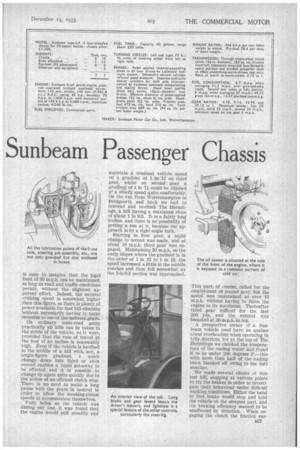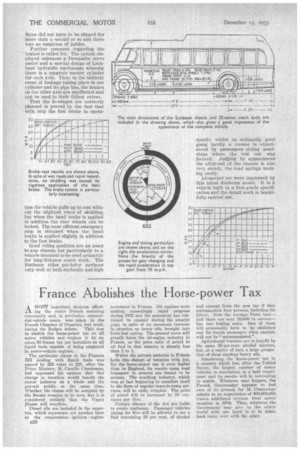A Fine Performance by a Sunbeam Passenger Chassis
Page 44

Page 45

Page 46

If you've noticed an error in this article please click here to report it so we can fix it.
The Value of a High-powered Engine and Adequate Brakes Clearly Demonstrated in a Test Run Which Showed the Chassis to be Roadworthy, Well Sprung and Easily Manceuvrable
ONE expects a product of the Sunbeam Motor Car Co., Ltd., to be what is often termed by engineers "a good job," for the concern in question has produced highgrade automobiles for more than a quarter of a century. Accordingly it is only to be anticipated that the experience so gained will have been of inestimable value in the design end production of commercial vehicles. We set off, therefore, on a test run of one of the latest 32-seater coach chassis with . the ideas enumerated above in mind, and to say that we were not disappointed frt the results obtained Is a just reward of merit to the maker.
Probably the outstanding feature of the chassis under review is that a large, efficient and consequently, powerful engine is used, and as a careful eye has been kept by the designer upon the weight factor the chassis has an excellent turn of speed, accelerates, climbs hills and so on in a manner much akin to that of a private car.
When it is realized thdt, fully laden, there is available approximately 1 b.h.p. per cwt., the performance characteristic will be better understood, yet, despite a strenuous test run, a fuel consumption equivalent to over 6 m.p.g. was recorded. Hills were climbed fast and the run generally was planned so as to create an arduous set of circumstances.
Although when we took over, the chassis, and of course the engine, were practically, new and, consequently, the bearings somewhat stiff, It was rather a pleasant surprise to find that the unit fired instantly after the application of the electricstarter button. Having allowed the engine to run for a few minutes to warm it up, we moved off, the unit thereafter firing perfectly regularly and without any indication that the B26 mixture was on the lean side, despite almost Arctic weather conditions.
From this it will be gathered that in the summer time one might expect an even better fuel-consumption figure, for the conditions were • all against good carburation at the time when we put the Sunbeam through.its paces. .
Although all components used in the make-up of the chassis are robust, one does not feel any sensation of heaviness about the control. of the vehicle. For one thing, the brakes are servo applied and care has been taken to make the clutch operation as light as possible. Again, a long lever helps to make gear shifting easy, whilst the steer-' ing gear, despite the fact that it is moderately direct in action, is. nevertheless, quite light also.
Even when manmuvring the chassis at low road speeds there is no need for the driver to exert himself unduly in order to bring the front wheels from one lock to the other, whilst on the open road the action of steering is comparable with that of a pleasure ear.
So much for a general outline of the behaviour of the vehicle under service conditions. We will now turn to a consideration of actual performance. With a maximum speed in the neighbourhood of 50 m.p.h. it follows that the cruising speed is proportionately high, and it is easy to imagine that the legal limit of 30 m.p.h. can be maintained, so long as road and traffic conditions permit, without the slightest apparent effort. Indeed, the natural cruising speed is somewhat higher than this figure, so there is plenty of power available for fast hill-climbing without necessarily having to make recourse to one of the indirect gears.
On ordinary main-road going practically all hills can be taken in the stride of the vehicle, as it were, provided that the rate of travel at the foot of an incline is reasonably high. Even if the vehicle is baulked in the middle of a hill with, say, a single-figure gradient, a quick change down into third or even second enables a rapid get-away to be effected and it is possible to change up again quite quickly due to the action of an efficient clutch stop. There is no need to make a long pause with the gears in neutral in order to allow the meshing-pinion Speeds to accommodate themselves.
Tully laden as the vehicle was during our test, it was found that the engine would pull steadily and maintain a constant vehicle speed on a gradient of 1 fin 12 on third gear, whilst on second gear a gradienS• of 1 in 7i could be climbed at a stEady speed quite comfortably. On the run from Wolverhampton to Bridgnorth and hack we had to descend and re-climb The Hermitage, a hill having a maximum slope of about 1 in 9.3. It is a fairly long incline, and there is no possibility of getting a run at it, because the approach is by a right-angle turn.
Starting in first gear, a rapid change to second was made, and at about 18 m.p.h, third gear was en-P gaged. Maintaining 20 m.p.h. on the early slopes where the gradient is in the order of 1 in 12 to 1 in 13, the speed increased a little in the middle reaches and then fell somewhat as the 1-in-9.3 section was approached. This part, of :!ourse, called for the employment of second gear, but the speed was mapitained at over 15 m.p.h. without having to force the engine to its maximum. Thereafter third gear sufficed for the last 200 yds. and the summit was breasted at 30 -m.p.h. in top. . • A prospective owner of a Sunbeam vehicle need have no qualms about overheating when operating in billy districts, for at the top of The Hermitage we checked the temperature of the cooling water and found it to be under 200 degrees F.—this with more than half of the cooling block blanked off owing to the cold weather.
We made several climbs of this test hill, stopping at various points to try the brakes in order to investigate their behaviour under difficult working conditions. Either the hand or foot brake would stop and hold the vehicle on the steepest part, and. the braking efficiency seemed td be unaffected by direction, When engaging the clutch the friction sur faces did not have to be slipped for more than a second or se and there was no suspicion of judder.
Further comment regarding the brakes is called for. The system employed embraces a Dewandre servo motor and a special design of Lockheed hydraulic mechanism whereby there is a separate master Winder for each axle. Thus, in the unlikely event of leakage taking place in one cylinder and its pipe line, the brakes on the other axle are unaffected and can be used to their fullest extent.
That the leverages are correctly planned is proved by the fact that with only the foot brake in opera Lion the vehicle pulls up to rest without the slightest trace of skidding, but when the hand brake is applied in addition the rear wheels can be locked. The most efficient emergency stop is obtained when the, hand brake is applied slightly in addition to the foot brake.
Good riding qualities are an asset to any chassis, but particularly to a vehicle intended to be used primarily for long-distance coach work. The Sunbeam rides pot-holey surfaces very well at both moderate and high speeds, whilst on ordinarily good going hardly a tremor is experienced by passengers sitting amidships where the test cab was located. Judging by appearances the after-end of the chassis is also very steady, the road springs working easily.
Altogether we were impressed. by this latest Sunbeam model. It is a vehicle built to a first-grade specification and the detail work is beautifully carried out.




































































































